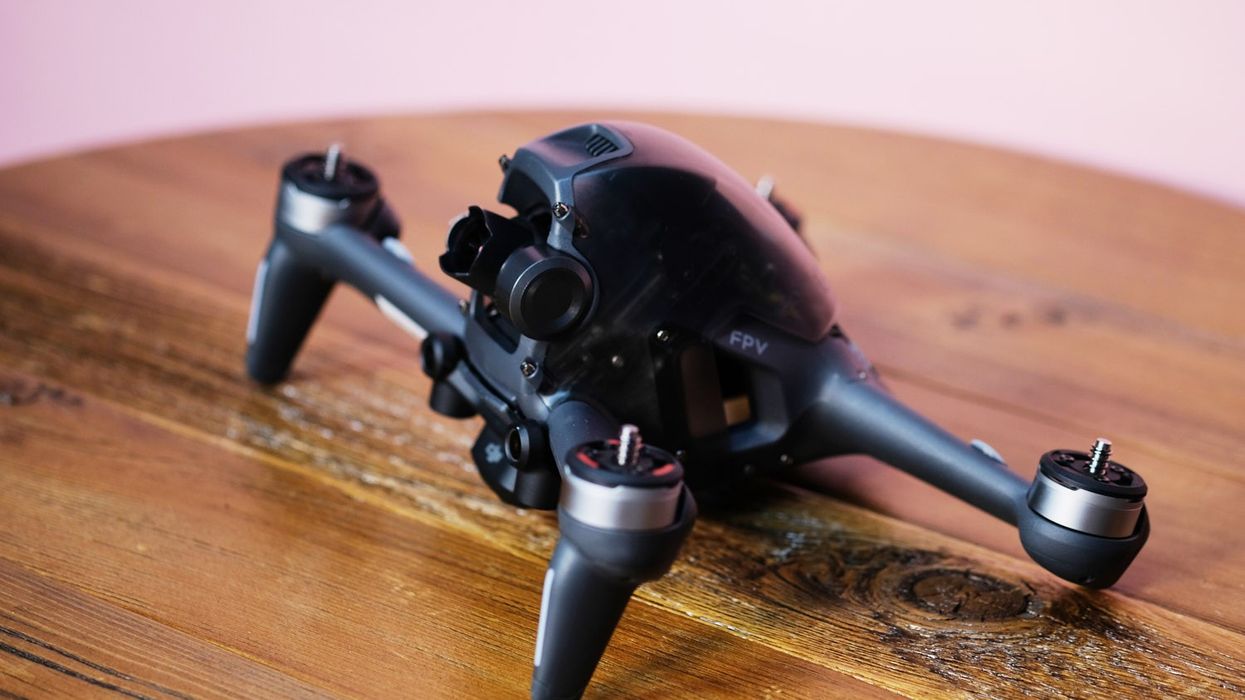DJI FPV Drone Review: Fun, but Not for Filmmakers
Here's what filmmakers should note about DJI's FPV drone.

When DJI first released their FPV drone, we were cautiously curious: while not directly targeted at the filmmaking community, some of the speed and agility it offered seemed like it might be useful. Filmmakers are notorious for finding ways to bend things to our needs.
DJI was nice enough to let us test fly it, and we tested it at Calvert Vaux and in upstate New York and walked away wildly impressed with how fun it is, but still cautious about its usefulness for filmmaking. There are going to be times where you might want to shoot with this, but it's going to be less useful as a film tool than something like the new Mavic Air 2S.
What is it?
The FPV drone is dedicated to one thing: acrobatic and high-speed fun flying with a first-person view for the operator. This isn't a "racing" drone per se; it's too heavy to be very competitive in the racing space. But it is sort of an entryway to drone racing for those curious who want an easy way to learn. Most racing drones require customization and are harder to fly. The FPV could potentially be the "simple to purchase" option to get someone up to speed and work as a gateway to faster drones.
But it's definitely not a filmmaking drone. While lines like the Inspire, Phantom, and Mavic have a built-in 3-axis stabilizer for the camera that allows for getting stabilized images while you shoot, the FPV camera is built into the unit directly.
To get a steady shot, you need to execute a steady shot. You can tilt that camera up and down, but that is primarily there to compensate for speed changing the angle of attack of the drone. As you speed up, the drone tilts downward, and you can pan the camera up to compensate.
The lack of a gimbal for stabilization makes this drone primarily designed for shots flying straight forward or straight back. To get a side-to-side or circular tracking shot, the drone is going to have to move sideways. While you can do that with this drone, moving sideways is going to tend to take the drone off level, and there won't be a gimbal to keep the image stable while you do that. If you watch carefully through the promo video, there are amazing, dynamic, beautiful shots, but there are a limited amount of directions of motion available.
The unit does come with the capability of shooting 4K 60p. For the shots it can do with ease, you can get pretty amazing imagery out of the FPV, but you need to be sure you are planning out your shots properly within its limitations.
Flying Modes
The FPV has three flying modes—N for normal, S for sport, and M for manual. N is going to feel familiar to anyone who has flown a DJI drone in recent years. The drone does a ton of work to interpret your controls to create a smooth flying path. It's a great mode to be in for simple takeoff and landing and flying close around obstacles, and it's a great way to get up to speed working with the drone.
One of the nice features of the FPV is a large physical switch on the front of the controller that lets you switch modes. So you can take off in N mode, then switch to S mode if you want more flexibility and speed while in the air. You can also switch into M in the air, but be forewarned. M, for manual mode, is a different mode of flying. The drone stops doing as much work for you, and you are given more direct controls over the system.
This allows for a lot more flexibility but also is just going to be more difficult. If you want the absolute top speed for the FPV, you'll need to be in M mode, but you don't want to start using M mode until you've had time to practice and get up to speed.
Training
DJI has helpfully crafted a phone app just for learning to fly the FPV in M mode, using a game engine that you control with the flight controller to preview for you the experience of working with a fully manual drone. This is a very useful feature of the FPV platform since flying in M mode is just more complicated than most users of a Phantom or a Mavic are going to be used to.
This app is awesome and has a series of escalating tutorials to help you practice how to work in manual mode, but also made us super nauseous. I rarely get motion sickness in real-world situations, but digital ones have triggered this in me before, and it's something to be aware of if you have had a similar response.
However, even though it uses the same head-mounted goggles as you will use in actual flight, I didn't have the same reaction with the unit actually physically flying. If you use the training app and discover that it makes you nauseous, that doesn't mean you won't be able to fly at all. Try flying it in the air first in N mode to get used to its controls and see if your system can handle that; mine did just fine.
While filmmakers like to think we can adapt anything to craft the images we want, in the end, the FPV isn't the ideal tool for capturing aerial images except for high speed and intense acrobatics. If you are looking to do something like the famous bowling alley video, the FPV would be a great contender, but be aware you are going to need a tremendous amount of practice, even if you are already experienced in the more traditional DJI offerings like the Mavic lineup.
Goggles
But what about those amazing goggles? The goggles are indeed amazing. They are so good, in fact, that it seems reasonable that DJI will expand support for them to other platforms eventually. It is truly a "fun" way to operate the camera.
Here we have to note, again, that while it's super-duper fun and a great way to enjoy yourself, it's not necessarily what a filmmaker is looking for in terms of operating. While setting up a shot most of you want to be looking at the drone and its flight path to see what is coming to stage a cool reveal. That isn't possible immersed in the goggles.
Conclusion
Should you get an FPV? If you are looking for fun, definitely. It's just a tremendous amount of fun to fly. If you have a specific project coming up where you need speed, tremendous agility, and have a ton of time to practice? Then the FPV might well be the right drone for that project, especially since its 4K 60p imagery stands up quite well.
But if you are looking for something that will be competitive at lower speeds, easier to fly, with stabilized imagery, you are going to be better served looking at something like the Mavic 2 Pro or the new Air 2S. Those high speeds that the FPV offers are just not that useful in that many shooting situations, and the skill required to execute on those shots will take time to develop for most.









![Ethos, Pathos, Logos: 20 Effective Ways to Advertise [Infographic]](https://nofilmschool.com/media-library/ethos-pathos-logos-20-effective-ways-to-advertise-infographic.jpg?id=34064614&width=600&height=600&quality=90&coordinates=560%2C0%2C0%2C0)



